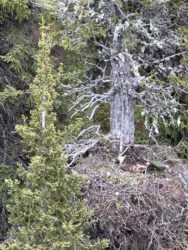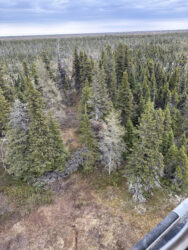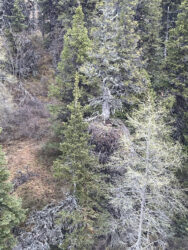By Andrew Berry
Bernheim is happy to announce a new research partnership with Parks Canada and Conservation Science Global to monitor golden eagle nests as part of the ongoing Golden Eagle Research project. This international collaboration focuses on better understanding the nesting territory in Wapusk National Park of Athena; the golden eagle Bernheim has been tracking since 2019. Until this year, only aerial photos of the landscape were available. They provided a broad context of landscape features and habitats. Still, many questions remained about the eagle’s nests and behavior during her time in Wapusk National Park from April to October. Wapusk National Park is a remote wilderness in the Hudson Bay Lowlands that supports incredible wildlife, such as migratory birds, polar bears, wolves, caribou, and wolverine.
Using nest locations gathered from Bernheim’s tracking data of Athena, researchers at Parks Canada have visited two nests to investigate and capture images of the trees, lake, and surrounding landscape.
In early June, researchers with Parks Canada working at Wapusk National Park conducted flyovers of Athena’s nest. They captured images of her incredible habitat – the large lakes and vast wilderness in Wapusk National Park. They captured images of several golden eagles, including one presumed to be Athena, identified by her tracking device while sitting on a nest. Another image captured a golden eagle flying nearby, presumed to be Athena’s mate. These images are a significant step forward in our research to understand golden eagle habitat in both winter and summer ranges.
The trees are stunted and scattered because Wapusk National Park is a vast tundra shrub landscape. Not many large groves of trees exist, but the golden eagles have built their nests in some of the largest trees in the area, which we believe to be white spruce (Picea glauca). Below the nests, we can see what looks to be a peat bog landscape with rocky outcrops and open spaces. Trees in the tundra are slow growing – often stunted trees can be hundreds of years old – and their location along the lake’s eastern edge creates favorable conditions for the eagles’ nests.
Golden eagles are typically cliff nesters throughout their global range, but here in Wapusk use trees where cliffs are non-existent and prey is abundant. The lakes the eagles nest beside are approximately 800 acres, with substantial shoreline for waterfowl that nest during summer and provide a primary food source. A small island visible in the middle of the first lake would provide an excellent nesting site for geese and ducks. Another image of the second nest site shows a remote lake with a boggy wetland shoreline. Look closely to see an eagle sitting along the coastline, looking out across the vast lake.
This research project hopes to answer important questions about golden eagles’ behavior in Canada. What are they preying upon during their months in the north? What threats do they face from wildlife and weather while on the nest? How do they cooperate during nesting, and are they successful in fledging their offspring? Finally, our Bernheim team is particularly interested in whether the offspring would migrate with their parents to Bernheim in the fall.
Our collaborators at Parks Canada are hoping to install cameras on adjacent trees that would allow us to answer some of these remaining questions. The cameras would be non-intrusive and installed during winter when eagles are on their southern range at Bernheim. They would capture images throughout the eagles’ time in Wapusk National Park and will provide valuable data about their behavior and the surrounding environment.
Stay tuned as we await Athena’s return to Bernheim after her nesting season in Wapusk National Park. The eagles should start migrating south in October towards cellular towers that allow Athena’s transmitter to upload summer data and provide key details about the nesting season. A special thanks to Beckham Bird Club, Cellular Tracking Technologies, Conservation Science Global Inc., Parks Canada, and all the supporters of Birds of Bernheim that make this incredible project possible. The support from Bernheim’s members, volunteers, staff, and donors are what allow us to protect golden eagles and steward their winter habitats.







